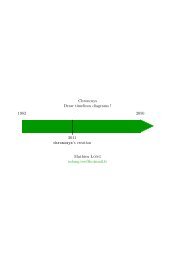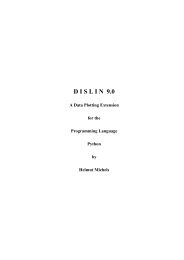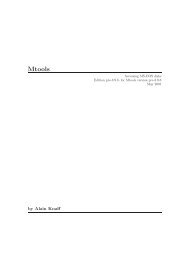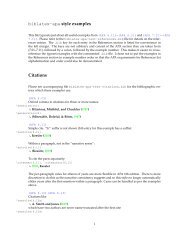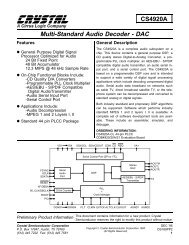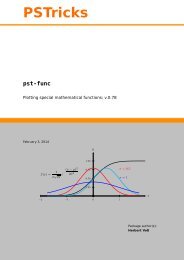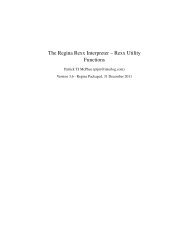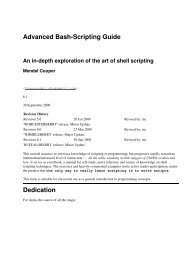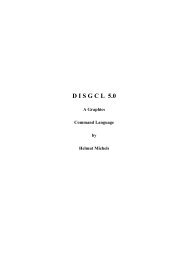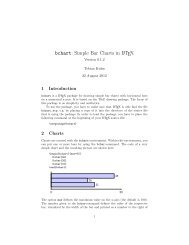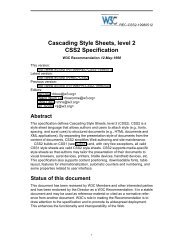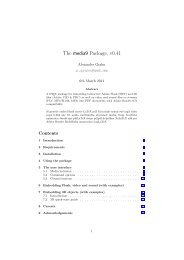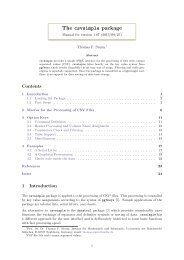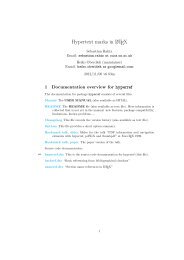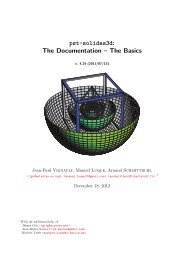Documenation of mdframed
Documenation of mdframed
Documenation of mdframed
Create successful ePaper yourself
Turn your PDF publications into a flip-book with our unique Google optimized e-Paper software.
The <strong>mdframed</strong> package 1<br />
auto-split frame environment<br />
Marco Daniel, Elke Schubert 1.9b 2013/07/01<br />
The standard methods for framing text (\fbox or \fcolorbox) require you to handle<br />
page breaks by hand, meaning that you have to split the \fbox into two. The present<br />
package defines the environment <strong>mdframed</strong> which automatically deals with pagebreaks<br />
in framed text.<br />
By defining new environments the user may choose between several individual<br />
designs.<br />
Linked files: <strong>mdframed</strong>-example-default.pdf <strong>mdframed</strong>-example-tikz.pdf<br />
<strong>mdframed</strong>-example-pstricks.pdf<br />
<strong>mdframed</strong>-example-texsx.pdf<br />
FYI:<br />
I create a repository for <strong>mdframed</strong> on github where you can download<br />
the current development status.<br />
Contents<br />
1. Motivation 1<br />
2. Syntax 2<br />
3. The frames 3<br />
4. Commands 3<br />
5. Defining your own style 4<br />
6. Options 5<br />
6.1. Global Options . . . . . . . . . . 5<br />
6.2. Restoring the settings . . . . . . 6<br />
6.3. Options with lengths . . . . . . . 6<br />
6.4. Colored Options . . . . . . . . . 7<br />
6.5. Shadows . . . . . . . . . . . . . . 8<br />
6.6. Hidden Lines . . . . . . . . . . . 8<br />
6.7. Working in twoside-mode . . . . 9<br />
6.8. Footnotes . . . . . . . . . . . . . 9<br />
6.9. Page breaks . . . . . . . . . . . . 9<br />
6.10. Frametitle . . . . . . . . . . . . . 10<br />
6.11. Title commands inside the environment<br />
. . . . . . . . . . . . . . 11<br />
6.12. General options . . . . . . . . . . 12<br />
6.13. TikZ options . . . . . . . . . . . 13<br />
6.14. PSTricks options . . . . . . . . . 13<br />
7. Hooks and Bools 14<br />
8. Theorems 15<br />
9. complexe example – Matlab Terminal 16<br />
10.Examples 17<br />
11.Errors, Warnings and Messages 42<br />
12.Known Limitations 43<br />
13.ToDo 43<br />
14.Acknowledgements 44<br />
A. More information 45<br />
1. Motivation<br />
Many users wish to (further) emphasize lemmata, definitions, pro<strong>of</strong>s, etc. The package <strong>mdframed</strong><br />
allows you to create environments with breakable frames. I think an example is the best way to<br />
1 Extending the package framed.sty
2. Syntax<br />
demonstrate its properties.<br />
Theorem 1.1 (Pythagorean theorem) In any right triangle, the area<br />
<strong>of</strong> the square whose side is the hypotenuse is equal to the sum <strong>of</strong> the areas<br />
<strong>of</strong> the squares whose sides are the two legs.<br />
a 2 + b 2 = c 2<br />
The frame was defined with the following settings.<br />
\newmdtheoremenv [%<br />
outerlinewidth = 2 ,%<br />
roundcorner = 10 pt ,%<br />
leftmargin = 40 ,%<br />
rightmargin = 40 ,%<br />
backgroundcolor = y e l l o w ! 4 0 ,%<br />
o u t e r l i n e c o l o r = b l u e ! 7 0 ! black ,%<br />
innertopmargin = \topskip ,%<br />
s p l i t t o p s k i p = \topskip ,%<br />
ntheorem = t r u e ,%<br />
] { theorem }{ Theorem } [ s e c t i o n ]<br />
\begin { theorem } [ P y t h a g o r e a n theorem ]<br />
. . .<br />
\end{theorem}<br />
2. Syntax<br />
Required packages by <strong>mdframed</strong><br />
The package itself loads the packages<br />
kvoptions xparse etoolbox color.<br />
Depending on the option framemthod <strong>mdframed</strong> will load<br />
Load the package as usual:<br />
xcolor tikz pstricks.<br />
\usepackage[]{<strong>mdframed</strong>}<br />
Only the option framemethod should be loaded by the optional argument <strong>of</strong> \usepackage. All<br />
other options should be loaded with \mdfsetup or related environments. The package should be<br />
loaded after amsthm if you need the package.<br />
Provided environment<br />
The package defines only one environment with the following syntax:<br />
\begin{<strong>mdframed</strong>}[]<br />
2013/07/01 revision: 212 <strong>mdframed</strong> 2
4. Commands<br />
<br />
\end{<strong>mdframed</strong>}<br />
To create own environments with <strong>mdframed</strong> see section 4.<br />
Autodetecting floats<br />
<strong>mdframed</strong> detects whether the environment is used inside float or minipage environments. If you<br />
use <strong>mdframed</strong> in such an environment <strong>mdframed</strong> will use the option nobreak automatically.<br />
3. The frames<br />
Normally you can say <strong>mdframed</strong> draws only some lines. To allow page breaks the following designs<br />
are supported. If you load the package with framemethod=default you can only draw a single line.<br />
Inside the gray boxes <strong>of</strong> the images below the text will be printed.<br />
Frame <strong>of</strong> a<br />
single page<br />
First box – first<br />
part <strong>of</strong> the output<br />
Second box – last<br />
part <strong>of</strong> the output<br />
Middle box –<br />
middle part<br />
<strong>of</strong> the output<br />
Figure 1: The basic frames<br />
4. Commands<br />
The following commands should countenance your by the handling with <strong>mdframed</strong>.<br />
\newmdenv[options]{env-name}<br />
The command allows the definition <strong>of</strong> a new environment which is surrounded by <strong>mdframed</strong>. The<br />
command has the following syntax:<br />
\newmdenv[]{Name <strong>of</strong> the environment}<br />
In this way you can say:<br />
2013/07/01 revision: 212 <strong>mdframed</strong> 3
5. Defining your own style<br />
\newmdenv[linecolor=red,frametitle=Infobox]{infobox}<br />
\begin{infobox}[backgroundcolor=yellow]<br />
Some Infos\ldots<br />
\end{infobox}<br />
\renewmdenv[options]{env-name}<br />
By using this command you can redefine environments which are created by \newmdenv.<br />
\surroundwith<strong>mdframed</strong>[options]{environment}<br />
Sometimes you have predefined environments. This commands allows you to surround an<br />
predefined environment with <strong>mdframed</strong> without changing the original name. To set a <strong>mdframed</strong><br />
around the environment verbatim you can simple say.<br />
\surroundwith<strong>mdframed</strong>[linewidth=2pt]{verbatim}<br />
\mdflength{options}<br />
If you want to work with length defined by <strong>mdframed</strong> (for example innerleftmargin) you can use<br />
the command \mdflength.<br />
The distance is \hspace{\mdflength{innerleftmargin}}<br />
\the\mdflength{innerleftmargin}<br />
The result will be:<br />
The distance is<br />
10.0pt<br />
\mdfsetup{options}<br />
To set the options you can use the optional argument <strong>of</strong> \usepackage or you can use the command<br />
\mdfsetup which is not limited to the preamble. Inside a group the settings work only local.<br />
At this point I want to recommend the usage <strong>of</strong> the command \mdfsetup instead <strong>of</strong><br />
setting package option via the optional argument <strong>of</strong> \usepackage. So you are avoiding<br />
breaking <strong>of</strong> non robust commands. 2 The sole exception is the option framemethod which<br />
must given as an optional argument <strong>of</strong> \usepackage.<br />
5. Defining your own style<br />
In the next section all options are introduced. However instead <strong>of</strong> passing them global or as an<br />
optional argument <strong>of</strong> the environment you can define your own styles. The method is as follows<br />
\mdfdefinestyle{style name}{options}<br />
\mdfdefinestyle allows the user to define different styles which can be used as an option <strong>of</strong><br />
<strong>mdframed</strong> via style.<br />
\mdfapptodefinestyle{style name}{options}<br />
This commands add options to a defined style. 3<br />
2 Thanks to Heiko Oberdiek and Philipp Stephani kvoptions-Declaration von Optionen schlägt fehl<br />
3 Thanks to Martin Scharrer and Enrico Gregorio:<br />
http://tex.stackexchange.com/questions/34684/argument-<strong>of</strong>-setkeys<br />
2013/07/01 revision: 212 <strong>mdframed</strong> 4
6. Options<br />
style<br />
If you define a special style with \mdfdefinestyle you can use the key style to load the style.<br />
<strong>mdframed</strong> has no predefined styles yet.<br />
Here a small example:<br />
\mdfdefinestyle{mystyle}{leftmargin=1cm,linecolor=blue}<br />
\begin{<strong>mdframed</strong>}[style=mystyle]<br />
foo<br />
\end{<strong>mdframed</strong>}<br />
xcolor<br />
6. Options<br />
The package provides various options to manipulate frames. In the following section all options<br />
are listed. Some internal macros which can be manipulated are not shown in this documentation.<br />
The listed options are divided in global and local options. The global options can not be used<br />
inside \mdfsetup.<br />
6.1. Global Options<br />
The following options are only global options.<br />
default=none<br />
By setting this key, the package xcolor will be loaded with the given value(s). Without any value<br />
<strong>mdframed</strong> loads the package color without any options. If the package xcolor is already loaded<br />
the given option will be ignored. I recommend to load xcolor before <strong>mdframed</strong>.<br />
framemethod<br />
default=default<br />
With this key you can change the way frames are drawn. You can decide whether the frame is<br />
drawn with<br />
1. L A TEX-commands \hrule, \vrule, \rule,<br />
2. TikZ (the package TikZ will be loaded) or<br />
3. PSTricks (the package pstricks will be loaded).<br />
The option framemethod requires a string. Allowed combinations are listed in the following table.<br />
Table 1: Allowed keys for framemethod<br />
Method<br />
Allowed keys<br />
L A TEX-commands default, tex, latex, none, 0<br />
TikZ tikz, pgf, 1<br />
PSTricks pstricks, ps, postscript, 2<br />
If you are lazy you can also work with the following short forms: tikz, TikZ, pstricks, PSTricks<br />
or ps. Of course for the default method exists no key.<br />
FYI<br />
It is independently whether the method is written with no, one or more capital letter.<br />
All other options listed below can be set globally or locally and they are not limited to the<br />
preamble. I was trying to define self explained names.<br />
2013/07/01 revision: 212 <strong>mdframed</strong> 5
6.2. Restoring the settings 6. Options<br />
6.2. Restoring the settings<br />
Sometimes it’s useful to remove all done settings. Every default value is saved in a style wich can<br />
be called by the option default or a more suitable name style=defaultoptions. Both do the same.<br />
Here a small example:<br />
\mdfsetup{%<br />
middlelinecolor=red,<br />
middlelinewidth=2pt,<br />
backgroundcolor=red!10,<br />
roundcorner=10pt}<br />
\begin{<strong>mdframed</strong>}<br />
Text\par Text<br />
\end{<strong>mdframed</strong>}<br />
\begin{<strong>mdframed</strong>}[default]<br />
Text\par Text<br />
\end{<strong>mdframed</strong>}<br />
Text<br />
Text<br />
Text<br />
Text<br />
6.3. Options with lengths<br />
In figure (2) you can see the adjustable lengths (compare also figure (1)).<br />
skipabove<br />
leftmargin<br />
innerleftmargin<br />
innertopmargin<br />
Contents<br />
innerbottommargin<br />
innerrightmargin<br />
rightmargin<br />
skipbelow<br />
Figure 2: adjustable lengths <strong>of</strong> <strong>mdframed</strong><br />
2013/07/01 revision: 212 <strong>mdframed</strong> 6
6.4. Colored Options 6. Options<br />
defaultunit<br />
default=pt<br />
All lengths accept two kinds <strong>of</strong> input. The first one is a length (e.g. 2pt) and the second one is a<br />
number (e.g. 2) which will be multiplied by 1 defaultunit. To get a better overview, all length<br />
options with their default value are listet in a table. I think the names are self explained so that<br />
don’t describe it anymore. Although special hints and length are described below<br />
The first table lists the length for the geometry <strong>of</strong> the frame.<br />
skipabove = 0pt skipbelow = 0pt<br />
leftmargin = 0pt rightmargin = 0pt<br />
innerleftmargin = 10pt innerrightmargin = 10pt<br />
innertopmargin = 5pt innerbottommargin = 5pt<br />
Before the next options are introduced here an example where the described length are<br />
used.<br />
\mdfdefinestyle{mdfexample1}{leftmargin=1cm,rightmargin=2cm,%<br />
innerleftmargin=1cm,innerrightmargin=1cm,roundcorner=10pt}<br />
\begin{<strong>mdframed</strong>}[style=mdfexample1]<br />
In any right triangle, the area <strong>of</strong> the square whose side is the hypotenuse<br />
is equal to the sum <strong>of</strong> the areas <strong>of</strong> the squares whose sides are the two<br />
legs.<br />
\end{<strong>mdframed</strong>}<br />
In any right triangle, the area <strong>of</strong> the square whose side<br />
is the hypotenuse is equal to the sum <strong>of</strong> the areas <strong>of</strong> the<br />
squares whose sides are the two legs.<br />
The next table lists the options to manipulate the lines <strong>of</strong> <strong>mdframed</strong>. If you are working with<br />
framemethod=default you have only one line for framing.<br />
linewidth = 0.4pt innerlinewidth = 0pt middlelinewidth = 0.4pt<br />
outerlinewidth = 0pt roundcorner = 0pt<br />
If you are working width framemethod=tikz or framemethod=pstricks the option linewidth is an<br />
alias for the option middlelinewidth.<br />
6.4. Colored Options<br />
Now we want to bring some color on your frames. The limitation is equal the the length options.<br />
For framemethod=default you have only one line.<br />
linecolor = black innerlinecolor = black<br />
middlelinecolor = black<br />
outerlinecolor = black<br />
font<br />
backgroundcolor = white fontcolor = black<br />
default={}<br />
Although it’s no really a color options you can also specify the font <strong>of</strong> the contents. Therefor the<br />
option font can be used.<br />
Ok after we have some lengths and some colors we can improve our example.<br />
2013/07/01 revision: 212 <strong>mdframed</strong> 7
6.5. Shadows 6. Options<br />
\mdfapptodefinestyle{example1}{backgroundcolor=brown!20,%<br />
linecolor=red!40!black,linewidth=4pt}<br />
\begin{<strong>mdframed</strong>}[style=mdfexample1]<br />
In any right triangle, the area <strong>of</strong> the square whose side is the hypotenuse<br />
is equal to the sum <strong>of</strong> the areas <strong>of</strong> the squares whose sides are the two<br />
legs.<br />
\end{<strong>mdframed</strong>}<br />
In any right triangle, the area <strong>of</strong> the square whose side<br />
is the hypotenuse is equal to the sum <strong>of</strong> the areas <strong>of</strong><br />
the squares whose sides are the two legs.<br />
6.5. Shadows<br />
Another possibility to highlight a frame can be a shadow. The package <strong>mdframed</strong> supports some<br />
elementary options to add a shadow. For framemethod=tikz the library shadows is needed which<br />
must be loaded by the user by \usetikzlibrary{shadows}.<br />
shadowsize<br />
default=8 pt<br />
shadowcolor<br />
default=black!50<br />
If a shadow is used depends on the option shadow which can be either true or false. The option<br />
shadows enables two new options shadowsize and shadowcolor.<br />
\begin{<strong>mdframed</strong>}[backgroundcolor=gray!40,shadow=true,roundcorner=8pt]<br />
In any right triangle, the area <strong>of</strong> the square whose side is the hypotenuse<br />
is equal to the sum <strong>of</strong> the areas <strong>of</strong> the squares whose sides are the two<br />
legs.<br />
\end{<strong>mdframed</strong>}<br />
In any right triangle, the area <strong>of</strong> the square whose side is the hypotenuse is equal to the sum<br />
<strong>of</strong> the areas <strong>of</strong> the squares whose sides are the two legs.<br />
6.6. Hidden Lines<br />
The default behaoiur <strong>of</strong> the output was shown in a previous picture. <strong>mdframed</strong> <strong>of</strong>fers the possibility<br />
to print only requested lines. If you don’t want any right line you can say rightline=false. The<br />
table below listed all keys to this topic and shows their default setting.<br />
topline = true rightline = true<br />
leftline = true<br />
bottomline = true<br />
hidealllines<br />
If you want to disable all lines you can use the short from hidealllines.<br />
default=false<br />
2013/07/01 revision: 212 <strong>mdframed</strong> 8
6.7. Working in twoside-mode 6. Options<br />
6.7. Working in twoside-mode<br />
Many books are written in twoside mode. In those cases it’s better to set the margins related<br />
to the site. Instead <strong>of</strong> the explained options leftmargin and rightmargin you can work with the<br />
options outermargin and innermargin. Of course if you working in oneside mode the options have<br />
no effect. If you don’t want to work with outermargin and innermargin whether the document is<br />
done in twoside mode you can disable the behaviour by the option usetwoside. Allowed values<br />
for this key are true or false.<br />
6.8. Footnotes<br />
Inside the environment you can use the command \footnote as usual. <strong>mdframed</strong> uses the syntax<br />
<strong>of</strong> environment minipage with the same counter.<br />
Every footnote text will be collected inside a box and will be displayed at the end <strong>of</strong> the<br />
environment <strong>mdframed</strong>.<br />
footnotedistance<br />
default= \bigskipamount<br />
The length is the distance between the end <strong>of</strong> the environment <strong>mdframed</strong> and the displaying <strong>of</strong><br />
the \footnoterule.<br />
footnoteinside<br />
default=true<br />
The position <strong>of</strong> the footnotes can be changed with the option footnoteinside. The footnotes<br />
will be displayed at the end <strong>of</strong> the environment but you can decide whether the output is inside<br />
<strong>mdframed</strong> or after.<br />
Note<br />
The output <strong>of</strong> the footnotes with the option footnoteinside=false are not in a splitted frame. I<br />
think it isn’t useful because the first line <strong>of</strong> a new page shouldn’t be a footnote.<br />
nobreak<br />
6.9. Page breaks<br />
The package <strong>mdframed</strong> splits its content if neccessary. In figure 1 the default style for splitting is<br />
presented. However there a sevaral situations where no page preak should occur.<br />
default=false<br />
For this case you can use the option nobreak which is either true or false. As you can see in<br />
figure 1 the different elements have different ways <strong>of</strong> drawing. E.g. the middle part <strong>of</strong> <strong>mdframed</strong><br />
has only a left and a right line.<br />
everyline<br />
default=false<br />
If you want that all parts <strong>of</strong> <strong>mdframed</strong> get a whole frame you can work with the option everyline.<br />
Then all parts are displayed as a single frame.<br />
In a previous section the options innertopmargin and innerbottommaring were introduced. However<br />
if a page break occurs you have two new length options which influence the space at the<br />
breaking point.<br />
splittopskip<br />
Sets the length <strong>of</strong> the skip above the split part <strong>of</strong> the environment.<br />
splitbottomskip<br />
Sets the length <strong>of</strong> the skip below the split part <strong>of</strong> the environment.<br />
default=0 pt<br />
default=0 pt<br />
2013/07/01 revision: 212 <strong>mdframed</strong> 9
6.10. Frametitle 6. Options<br />
6.10. Frametitle<br />
In this section all relevant options <strong>of</strong> the frame title will be presented. They are not divided in<br />
their properties.<br />
frametitle<br />
default=none<br />
The environment gets a title. To set a title use frametitle={The Title <strong>of</strong> the frame} as an option<br />
<strong>of</strong> the environment.<br />
frametitlefont<br />
Sets the format <strong>of</strong> the frametitle.<br />
frametitlealignment<br />
Align the frametitle. This option must be set via \mdfsetup.<br />
default=\normalfont\bfseries<br />
default=\raggedleft<br />
frametitlerule<br />
Set this key to true to get a line between the frame title and the text.<br />
frametitlerulewidth<br />
Sets the width <strong>of</strong> the line between the text and the title <strong>of</strong> <strong>mdframed</strong>.<br />
frametitleaboveskip<br />
Sets the skip <strong>of</strong> the frame title to the margin above <strong>of</strong> <strong>mdframed</strong>.<br />
frametitlebelowskip<br />
Sets the skip <strong>of</strong> the frame title to the rule <strong>of</strong> the frame title.<br />
frametitlebackgroundcolor<br />
Sets the color <strong>of</strong> the background <strong>of</strong> the frametitle<br />
default=false<br />
default=.2 pt<br />
default=5 pt<br />
default=5 pt<br />
default=backroundcolor<br />
repeatframetitle<br />
default=false<br />
Repeat the frame title on every frame.<br />
The following picture demonstrates the behaviour <strong>of</strong> the lengths if the option frametitle is<br />
used.<br />
frame title<br />
frametitleaboveskip<br />
frametitlebelowskip<br />
splittopskip<br />
innertopmargin<br />
frametitlerulewidth<br />
frametitlerule=true<br />
Contents <strong>of</strong> the box<br />
Figure 3: Behavior <strong>of</strong> the lengths if frametitle is used<br />
FYI and Note<br />
The splitting <strong>of</strong> the frame title is really a fiddly issue. If you want to use the option repeatframetitle<br />
a splitting is more than wrong. On the other hand if you use the option repeatframetitle the<br />
user must prepare the contents well.<br />
2013/07/01 revision: 212 <strong>mdframed</strong> 10
6.11. Title commands inside the environment 6. Options<br />
6.11. Title commands inside the environment<br />
To provide titles inside the environment <strong>mdframed</strong> you can use \mdfsubtitle. The relavant options<br />
are listed below.<br />
\mdfsubtitle<br />
Set a title inside <strong>mdframed</strong> <strong>of</strong> the internal level 1.<br />
The command accepts one optional and one mandatory argument. The optional argument sets<br />
the option <strong>of</strong> <strong>mdframed</strong> whereby everything will be local. The second argument <strong>of</strong> subtitle also<br />
allows paragraph breaking.<br />
Breaks inside the \mdfsubtitle are not supported.<br />
\mdfsubtitle[]{the subtitle}<br />
6.11.1. Options related to the title <strong>of</strong> level 1<br />
subtitleaboveline<br />
Decide to draw a line above the subtile.<br />
subtitlebelowline<br />
Decide to draw a line below the subtitle.<br />
subtitlefont<br />
Sets the font for subtitles.<br />
subtitlebackgroundcolor<br />
Sets the background color <strong>of</strong> the subtitle between the above and below line.<br />
subtitleabovelinecolor<br />
Sets the line color <strong>of</strong> the line above.<br />
subtitlebelowlinecolor<br />
Sets the line color <strong>of</strong> the line below.<br />
subtitleabovelinewidth<br />
Sets the line width <strong>of</strong> the line above.<br />
subtitlebelowlinewidth<br />
Sets the line width <strong>of</strong> the line below.<br />
subtitleaboveskip<br />
Sets the skip before the subtitle line above will be drawn.<br />
subtitlebelowskip<br />
Sets the skip after the subtitle line below is drawn.<br />
subtitleinneraboveskip<br />
Sets the skip after the line above and the subtitle itself.<br />
subtitleinnerbelowskip<br />
Sets the skip after the subtitle and the line below.<br />
Here an example to demonstrate the behaviour:<br />
default=false<br />
default=false<br />
default=\normalfont\bfseries<br />
default=white<br />
default=black<br />
default=black<br />
default=0.8 pt<br />
default=0.6 pt<br />
default=\baselineskip<br />
default=1.2\baselineskip<br />
default=0.5\baselineskip<br />
default=0.5\baselineskip<br />
2013/07/01 revision: 212 <strong>mdframed</strong> 11
6.12. General options 6. Options<br />
Theorem<br />
Some Text . . .<br />
Notes<br />
Some Text . . .<br />
\newmdenv[%<br />
roundcorner=5pt,<br />
subtitlebelowline=true,subtitleaboveline=true,<br />
subtitlebackgroundcolor=yellow!70!white,<br />
backgroundcolor=blue!20!white,<br />
frametitle={Theorem},frametitlerule=true,<br />
frametitlebackgroundcolor=yellow!70!white,<br />
]{subtitleenv}<br />
\begin{subtitleenv}<br />
Some Text \ldots<br />
\mdfsubtitle{Notes}<br />
Some Text \ldots<br />
\end{subtitleenv}<br />
ntheorem<br />
6.12. General options<br />
Some options can’t be classified. Such options are listed in this section.<br />
default=false<br />
Before setting this boolean key, you have to load the package ntheorem. With this option you set<br />
the values \theorempreskipamount and \theorempostskipamount to 0 pt to avoid extra vertical skip.<br />
needspace<br />
default=0 pt<br />
Sometimes it is useful to set a minimum height before a frame should be splitted. For such cases<br />
you can use needspace. The option requires a length which sets the minimum height before a<br />
frame will be splitted.<br />
ignorelastdescenders<br />
default=false<br />
Try to ignore the last descenders <strong>of</strong> the environment <strong>mdframed</strong>. The complete idea was inspired by<br />
Tobias Weh and the solution was provided by Stefan Lemke. See How to make <strong>mdframed</strong> ignore<br />
descenders in last line Of course you have some more length which can be manipulate.<br />
userdefinedwidth<br />
align<br />
default=\linewidth<br />
Sets the width <strong>of</strong> the whole <strong>mdframed</strong> environment. The width represent the width including the<br />
line width and the inner margins. The outer margins will be ignored.<br />
default=left<br />
Sometimes it is useful to align the environment itself. For this you have the option align which<br />
can be set to the following strings:<br />
• left,<br />
• right and<br />
• center.<br />
2013/07/01 revision: 212 <strong>mdframed</strong> 12
6.13. TikZ options 6. Options<br />
The alignments left or right depend on the given lengths leftmargin and rightmargin. Later I<br />
will present an example to demonstrate my bad English explanation.<br />
Be aware <strong>of</strong> using this option please.<br />
6.13. TikZ options<br />
tikzsetting<br />
default={}<br />
With this key you can pass several options to \tikzset. Some examples are listed in the next<br />
section. It is very important to put the options <strong>of</strong> tikzsetting in brackets.<br />
apptotikzsetting<br />
default={}<br />
With this key you can add several options to tikzsetting. This key based on the idea <strong>of</strong><br />
manipulation <strong>of</strong> predefined keys <strong>of</strong> <strong>mdframed</strong>. The package <strong>mdframed</strong> defines via \tikzset the<br />
following keys to draw frames.<br />
• \tikzset{mdfbox/.style}<br />
• \tikzset{mdfcorners/.style}<br />
• \tikzset{mdfbackground/.style}<br />
• \tikzset{mdfinnerline/.style}<br />
• \tikzset{mdfouterline/.style}<br />
• \tikzset{mdfmiddleline/.style}<br />
• \tikzset{mdfframetitlerule/.style}<br />
• \tikzset{mdfframetitlebackground/.style}<br />
• \tikzset{mdfshadow/.style}<br />
Before you change one please have a look at the file md-frame-1.mdf to see the settings.<br />
6.14. PSTricks options<br />
pstrickssetting<br />
default={}<br />
With this key you can pass several options to \psset. For example if you want all lines dashed<br />
you will have to set pstrickssetting={linestyle=dashed}. It is very important to put the options<br />
<strong>of</strong> pstrickssetting in brackets.<br />
pstricksappsetting<br />
default={}<br />
<strong>mdframed</strong> works with defined styles for the different elements. By using \addtopsstyle in combination<br />
with this option you can expand the definition. The predefined styles are<br />
• mdfbackgroundstyle<br />
• mdfframetitlebackgroundstyle<br />
• mdfouterlinestyle<br />
• mdfinnerlinestyle<br />
• mdfmiddlelinestyle<br />
Before you change one please have a look at the file md-frame-2.mdf to see the settings.<br />
2013/07/01 revision: 212 <strong>mdframed</strong> 13
7. Hooks and Bools<br />
settings<br />
7. Hooks and Bools<br />
The following options and bool flags can be used by the any user. Of course some needs more<br />
experience than other.<br />
default={}<br />
This option allows the user to commit some macros at the beginning <strong>of</strong> <strong>mdframed</strong>. The given<br />
material is executed before the savebox starts.<br />
extra<br />
Add material to every drawn frame.<br />
default={}<br />
singleextra<br />
default={}<br />
With this key you can put extra material to the drawing environment <strong>of</strong> <strong>mdframed</strong> only for a non<br />
splitted frame.<br />
firstextra<br />
default={}<br />
With this key you can put extra material to the drawing environment <strong>of</strong> <strong>mdframed</strong> only for the<br />
first part <strong>of</strong> the splitted frame.<br />
middleextra<br />
default={}<br />
With this key you can put extra material to the drawing environment <strong>of</strong> <strong>mdframed</strong> only for the<br />
middle part <strong>of</strong> the splitted frame.<br />
This works only with framemethod=TikZ and PSTricks.<br />
secondextra<br />
default={}<br />
With this key you can put extra material to the drawing environment <strong>of</strong> <strong>mdframed</strong> only for the<br />
second part <strong>of</strong> the splitted frame.<br />
After you can add material to any part <strong>of</strong> the frame you can also detect which part <strong>of</strong> the<br />
frame is drawn. Therefor the bool flags are defined which can be test by \ifbool{boolflag}. All<br />
flags are set to true before the output <strong>of</strong> the content occurs.<br />
mdfsingleframe<br />
This bool is only true for a non splitting frame.<br />
mdffirstframe<br />
This bool is only for the first part <strong>of</strong> the frame true.<br />
mdfmiddleframe<br />
see above.<br />
default=false<br />
default=false<br />
default=false<br />
mdflastframe<br />
default=false<br />
see above.<br />
For the advanced users there are also some other hooks which can be used to manipulate the<br />
output:<br />
beforesingleframe<br />
Every given code to this option is executed before a single frame is is printed.<br />
aftersingleframe<br />
Every given code to this option is executed after a single frame is is printed.<br />
default={}<br />
default={}<br />
beforebreak<br />
default={}<br />
The value <strong>of</strong> this option is only executed at breakable frames. Related to the introduction the<br />
first and middle frame can be manipulated.<br />
afterbreak<br />
default={}<br />
2013/07/01 revision: 212 <strong>mdframed</strong> 14
8. Theorems<br />
The value <strong>of</strong> this option is only executed at breakable frames. Related to the introduction the<br />
first and middle frame can be manipulated.<br />
beforelastframe<br />
The option is executed only for the last frame <strong>of</strong> a splitted frame.<br />
afterlastframe<br />
The option is executed only for the last frame <strong>of</strong> a splitted frame.<br />
startcode<br />
Every code given to this option is executed at the beginning <strong>of</strong> the environment.<br />
startinnercode<br />
This option is executed at the beginning <strong>of</strong> the save box.<br />
endinnercode<br />
endcode<br />
This option is executed at the end <strong>of</strong> the save box.<br />
The code is executed at the end <strong>of</strong> the environment.<br />
8. Theorems<br />
default={}<br />
default={}<br />
default={}<br />
default={}<br />
default={}<br />
default={}<br />
In this section is described which commands can help you to define theorem environments with<br />
<strong>mdframed</strong>.<br />
\newmdtheoremenv<br />
Since the package is <strong>of</strong>ten used to highlight theorem environments, the package providesa command<br />
to simplify this process. The command has the following syntax:<br />
\newmdtheoremenv[]{}%<br />
[]{}[]<br />
The last four arguments are equivalent to the command \newtheorem. Only the first optional<br />
argument is able to pass <strong>mdframed</strong>-options. A simple example is:<br />
\theoremstyle{}<br />
\newmdtheoremenv[linecolor=blue]{lemma}{Lemma}[section]<br />
...<br />
\begin{lemma}[Some title]<br />
foo foo foo foo foo foo<br />
\end{lemma}<br />
So far there is no \renewmdtheoremenv!<br />
\mdtheorem<br />
This is a special kind <strong>of</strong> \newtheorem. The command has the following syntax.<br />
\mdtheorem[]{}%<br />
[]{}[]<br />
As you can see the arguments are equal to \newtheorem<br />
\theoremstyle. This is based on the following behavior.<br />
but the command ignores every<br />
2013/07/01 revision: 212 <strong>mdframed</strong> 15
9. complexe example – Matlab Terminal<br />
The command \mdtheorem creates two environments based on the given first mandatory argument.<br />
The first environment is named like the given argument and creates a numbered theorem. The<br />
second environment is named like the first mandatory argument with a star. This environment<br />
has the same formating but isn’t numbered.<br />
The syntax <strong>of</strong> the new defined environments is equal to the normal theorem environments.<br />
\begin{environment}[optional title]<br />
...<br />
\end{environment}<br />
What happened? The caption <strong>of</strong> the command will be set as the frame title. In this way all options<br />
<strong>of</strong> the frame title are available. Furthermore <strong>mdframed</strong> provides additional options explained<br />
below.<br />
theoremseparator<br />
default={:}<br />
Sets the separator <strong>of</strong> the caption and the title <strong>of</strong> the theorem. The theoremseparator will be<br />
printed only if an theorem title is given.<br />
theoremtitlefont<br />
Via the option frametitlefont you can manipulate the font <strong>of</strong> the frame title.<br />
theoremtitlefont allows to set a different font to the title <strong>of</strong> the theorem.<br />
theoremspace<br />
Sets the space after theoremseparator.<br />
Examples can be found in the attached files.<br />
9. complexe example – Matlab Terminal<br />
The following example was inspiered by a question on TeX.SX.<br />
Command Window<br />
fx<br />
% >> help sin<br />
% sin Sine <strong>of</strong> argument in radians.<br />
% sin(X) is the sine <strong>of</strong> the elements <strong>of</strong> X.<br />
%<br />
% See also asin, sind.<br />
%<br />
% Overloaded methods:<br />
% sdpvar/sin<br />
% codistributed/sin<br />
% gpuArray/sin<br />
%<br />
% Reference page in Help browser<br />
% doc sin<br />
%<br />
% >><br />
%<br />
default={}<br />
The option<br />
default=\space<br />
The code for this result is:<br />
\definecolor{DarkBlue}{rgb}{.11,.23,.60}<br />
\mdfdefinestyle{commandline}%<br />
{leftmargin=5pt, rightmargin=10pt,innerleftmargin=15pt,<br />
middlelinecolor=DarkBlue,<br />
middlelinewidth=2pt,<br />
frametitlerule=false,<br />
2013/07/01 revision: 212 <strong>mdframed</strong> 16
10. Examples<br />
backgroundcolor=black!10!white,<br />
frametitle={Command Window},<br />
frametitlefont={\normalfont\sffamily\color{white}\hspace{−1em}},<br />
frametitlebackgroundcolor=DarkBlue,<br />
singleextra={\draw[black!20,line width=12pt]<br />
($(O)+(7pt,1pt)$) −−<br />
($(O|−P)+(7pt,−\mdfframetitleboxtotalheight)−(0,1pt)$);<br />
\node[inner sep=0pt,color=black]at ($(O)+(7pt,9pt)$)%<br />
{$\scriptstyle f\!x$}; },<br />
nobreak,<br />
}<br />
\lstnewenvironment{script} {%<br />
\lstset{language=Matlab,basicstyle=\tiny\ttfamily,breaklines=true,%<br />
aboveskip=0pt,belowskip=0pt}}{}<br />
\surroundwith<strong>mdframed</strong>[style=commandline]{script}<br />
\begin{script}<br />
>> help sin<br />
sin Sine <strong>of</strong> argument in radians.<br />
sin(X) is the sine <strong>of</strong> the elements <strong>of</strong> X.<br />
See also asin, sind.<br />
Overloaded methods:<br />
sdpvar/sin<br />
codistributed/sin<br />
gpuArray/sin<br />
Reference page in Help browser<br />
doc sin<br />
>><br />
\end{script}<br />
10. Examples<br />
I outsource the examples in four files documentation. The files are<br />
<strong>mdframed</strong>-example-default<br />
Demonstration <strong>of</strong> examples created with framemethod=default.<br />
<strong>mdframed</strong>-example-tikz<br />
Demonstration <strong>of</strong> examples created with framemethod=TikZ.<br />
<strong>mdframed</strong>-example-pstricks<br />
Demonstration <strong>of</strong> examples created with framemethod=pstricks.<br />
<strong>mdframed</strong>-example-texsx<br />
Demonstration <strong>of</strong> examples like interaction with listings<br />
The examples are <strong>of</strong>ten not equivalent but normally they can be adapted to another method.<br />
So I really recommend to have a look to all example files.<br />
The Korean TEXGroup created a very nice presentation. I want to show the link because it’s<br />
really a great work: kts 2012 <strong>mdframed</strong>.<br />
2013/07/01 revision: 212 <strong>mdframed</strong> 17
The <strong>mdframed</strong> package<br />
Examples for framemethod=default<br />
Marco Daniel 1.9b 2013/07/01<br />
In this document I collect various examples for framemethod=default. Some presented<br />
examples are more or less exorbitant.<br />
Contents<br />
1 Loading 1<br />
2 Examples 1<br />
Example 1 – very simple . . . . . . . . 2<br />
Example 2 – hidden line + frame title 2<br />
Example 3 – colored frame title . . . . 2<br />
Example 4 – framed picture which is<br />
centered . . . . . . . . . . . . . . 3<br />
Example 5 – Theorem environments . 3<br />
Example 6 – theorem with separate<br />
header and the help <strong>of</strong> TikZ (complex)<br />
. . . . . . . . . . . . . . . . 4<br />
Example 7 – hide only a part <strong>of</strong> a line 5<br />
1 Loading<br />
In the preamble only the package <strong>mdframed</strong> with the option framemethod=default is loaded. All<br />
other modifications will be done by \mdfdefinestyle or \mdfsetup.<br />
Note<br />
Every \global inside the examples is necessary to work with my own created environment<br />
tltxmdfexample*.<br />
2 Examples<br />
All examples have the following settings:<br />
\mdfsetup{skipabove=\topskip,skipbelow=\topskip}<br />
\newrobustcmd\ExampleText{%<br />
An \textit{inhomogeneous linear} differential equation has the form<br />
\begin{align}<br />
L[v ] = f,<br />
\end{align}<br />
where $L$ is a linear differential operator, $v$ is the dependent<br />
variable, and $f$ is a given non−zero function <strong>of</strong> the independent<br />
variables alone.<br />
}
Example 1 – very simple<br />
2 Examples<br />
Example 1 – very simple<br />
\global\mdfdefinestyle{exampledefault}{%<br />
linecolor=red,linewidth=3pt,%<br />
leftmargin=1cm,rightmargin=1cm<br />
}<br />
\begin{<strong>mdframed</strong>}[style=exampledefault]<br />
\ExampleText<br />
\end{<strong>mdframed</strong>}<br />
An inhomogeneous linear differential equation has the form<br />
L[v] = f, (1)<br />
where L is a linear differential operator, v is the dependent variable, and f is a<br />
given non-zero function <strong>of</strong> the independent variables alone.<br />
Example 2 – hidden line + frame title<br />
\global\mdfapptodefinestyle{exampledefault}{%<br />
topline=false,bottomline=false}<br />
\begin{<strong>mdframed</strong>}[style=exampledefault,frametitle={Inhomogeneous linear}]<br />
\ExampleText<br />
\end{<strong>mdframed</strong>}<br />
Inhomogeneous linear<br />
An inhomogeneous linear differential equation has the form<br />
L[v] = f, (2)<br />
where L is a linear differential operator, v is the dependent variable, and f is a<br />
given non-zero function <strong>of</strong> the independent variables alone.<br />
Example 3 – colored frame title<br />
\global\mdfapptodefinestyle{exampledefault}{%<br />
rightline=true,innerleftmargin=10,innerrightmargin=10,<br />
frametitlerule=true,frametitlerulecolor=green,<br />
frametitlebackgroundcolor=yellow,<br />
frametitlerulewidth=2pt}<br />
\begin{<strong>mdframed</strong>}[style=exampledefault,frametitle={Inhomogeneous linear}]<br />
2013/07/01 revision: 212 <strong>mdframed</strong>-example-default 2
Example 4 – framed picture which is centered<br />
2 Examples<br />
\ExampleText<br />
\end{<strong>mdframed</strong>}<br />
Inhomogeneous linear<br />
An inhomogeneous linear differential equation has the form<br />
L[v] = f, (3)<br />
where L is a linear differential operator, v is the dependent variable, and f is a<br />
given non-zero function <strong>of</strong> the independent variables alone.<br />
Example 4 – framed picture which is centered<br />
\begin{<strong>mdframed</strong>}[userdefinedwidth=6cm,align=center,<br />
linecolor=blue,linewidth=4pt]<br />
\textit{CTAN lion drawing by Duane Bibby; thanks to \url{www.ctan.org}}<br />
\IfFileExists{ctan−lion.png}%<br />
{\includegraphics[width=\linewidth]{ctan−lion.png}}%<br />
{\rule{\linewidth}{4cm}}%<br />
\end{<strong>mdframed</strong>}<br />
CTAN lion drawing by Duane<br />
Bibby; thanks to www.ctan.org<br />
Example 5 – Theorem environments<br />
\mdfdefinestyle{theoremstyle}{%<br />
linecolor=red,linewidth=2pt,%<br />
frametitlerule=true,%<br />
frametitlebackgroundcolor=gray!20,<br />
innertopmargin=\topskip,<br />
}<br />
\mdtheorem[style=theoremstyle]{definition}{Definition}<br />
\begin{definition}<br />
2013/07/01 revision: 212 <strong>mdframed</strong>-example-default 3
Example 6 – theorem with separate header and the help <strong>of</strong> TikZ (complex)<br />
2 Examples<br />
\ExampleText<br />
\end{definition}<br />
\begin{definition}[Inhomogeneous linear]<br />
\ExampleText<br />
\end{definition}<br />
\begin{definition∗}[Inhomogeneous linear]<br />
\ExampleText<br />
\end{definition∗}<br />
Definition 1<br />
An inhomogeneous linear differential equation has the form<br />
L[v] = f, (4)<br />
where L is a linear differential operator, v is the dependent variable, and f is a given non-zero<br />
function <strong>of</strong> the independent variables alone.<br />
Definition 2: Inhomogeneous linear<br />
An inhomogeneous linear differential equation has the form<br />
L[v] = f, (5)<br />
where L is a linear differential operator, v is the dependent variable, and f is a given non-zero<br />
function <strong>of</strong> the independent variables alone.<br />
Definition: Inhomogeneous linear<br />
An inhomogeneous linear differential equation has the form<br />
L[v] = f, (6)<br />
where L is a linear differential operator, v is the dependent variable, and f is a given non-zero<br />
function <strong>of</strong> the independent variables alone.<br />
Example 6 – theorem with separate header and the help <strong>of</strong> TikZ (complex)<br />
\newcounter{theo}[section]<br />
\newenvironment{theo}[1][]{%<br />
\stepcounter{theo}%<br />
\ifstrempty{#1}%<br />
{\mdfsetup{%<br />
frametitle={%<br />
\tikz[baseline=(current bounding box.east),outer sep=0pt]<br />
2013/07/01 revision: 212 <strong>mdframed</strong>-example-default 4
Example 7 – hide only a part <strong>of</strong> a line<br />
2 Examples<br />
\node[anchor=east,rectangle,fill=blue!20]<br />
{\strut Theorem~\thetheo};}}<br />
}%<br />
{\mdfsetup{%<br />
frametitle={%<br />
\tikz[baseline=(current bounding box.east),outer sep=0pt]<br />
\node[anchor=east,rectangle,fill=blue!20]<br />
{\strut Theorem~\thetheo:~#1};}}%<br />
}%<br />
\mdfsetup{innertopmargin=10pt,linecolor=blue!20,%<br />
linewidth=2pt,topline=true,<br />
frametitleaboveskip=\dimexpr−\ht\strutbox\relax,}<br />
\begin{<strong>mdframed</strong>}[]\relax%<br />
}{\end{<strong>mdframed</strong>}}<br />
\begin{theo}[Inhomogeneous Linear]<br />
\ExampleText<br />
\end{theo}<br />
\begin{theo}<br />
\ExampleText<br />
\end{theo}<br />
Theorem 1: Inhomogeneous Linear<br />
An inhomogeneous linear differential equation has the form<br />
L[v] = f, (7)<br />
where L is a linear differential operator, v is the dependent variable, and f is a given non-zero<br />
function <strong>of</strong> the independent variables alone.<br />
Theorem 2<br />
An inhomogeneous linear differential equation has the form<br />
L[v] = f, (8)<br />
where L is a linear differential operator, v is the dependent variable, and f is a given non-zero<br />
function <strong>of</strong> the independent variables alone.<br />
Example 7 – hide only a part <strong>of</strong> a line<br />
The example below is inspired by the following post on StackExchange Theorem decorations that<br />
stay with theorem environment<br />
\makeatletter<br />
\newlength{\interruptlength}<br />
\newrobustcmd\interruptrule[3]{%<br />
2013/07/01 revision: 212 <strong>mdframed</strong>-example-default 5
Example 7 – hide only a part <strong>of</strong> a line<br />
2 Examples<br />
\color{#1}%<br />
\hspace∗{\dimexpr\mdfboundingboxwidth+<br />
\mdf@innerrightmargin@length\relax}%<br />
\rule[\dimexpr−\mdfboundingboxdepth+<br />
#2\interruptlength\relax]%<br />
{\mdf@middlelinewidth@length}%<br />
{\dimexpr\mdfboundingboxtotalheight−#3\interruptlength\relax}%<br />
}<br />
\newrobustcmd\overlaplines[2][white]{%<br />
\mdfsetup{everyline=false}%<br />
\setlength{\interruptlength}{#2}<br />
\appto\mdf@frame@leftline@single{\llap{\interruptrule{#1}{1}{2}}}<br />
\appto\mdf@frame@rightline@single{\rlap{\interruptrule{#1}{1}{2}}}<br />
\appto\mdf@frame@leftline@first{\llap{\interruptrule{#1}{0}{1}}}<br />
\appto\mdf@frame@rightline@first{\rlap{\interruptrule{#1}{0}{1}}}<br />
\appto\mdf@frame@leftline@second{\llap{\interruptrule{#1}{1}{1}}}<br />
\appto\mdf@frame@rightline@second{\rlap{\interruptrule{#1}{1}{1}}}<br />
\appto\mdf@frame@leftline@middle{\llap{\interruptrule{#1}{0}{0}}}<br />
\appto\mdf@frame@rightline@middle{\rlap{\interruptrule{#1}{0}{0}}}<br />
}<br />
\makeatother<br />
\overlaplines{2.5ex}<br />
\begin{<strong>mdframed</strong>}[linecolor=blue,linewidth=8pt]<br />
\ExampleText<br />
\end{<strong>mdframed</strong>}<br />
\overlaplines[blue!70!black!20]{2.5ex}<br />
\begin{<strong>mdframed</strong>}[linecolor=blue,linewidth=8pt]<br />
\ExampleText<br />
\end{<strong>mdframed</strong>}<br />
An inhomogeneous linear differential equation has the form<br />
L[v] = f, (9)<br />
where L is a linear differential operator, v is the dependent variable, and f is a given<br />
non-zero function <strong>of</strong> the independent variables alone.<br />
An inhomogeneous linear differential equation has the form<br />
L[v] = f, (10)<br />
where L is a linear differential operator, v is the dependent variable, and f is a given<br />
non-zero function <strong>of</strong> the independent variables alone.<br />
2013/07/01 revision: 212 <strong>mdframed</strong>-example-default 6
The <strong>mdframed</strong> package<br />
Examples for framemethod=TikZ<br />
Marco Daniel 1.9b 2013/07/01<br />
In this document I collect various examples for framemethod=TikZ. Some presented<br />
examples are more or less exorbitant.<br />
Contents<br />
1 Loading 1<br />
2 Examples 1<br />
Example 1 – round corner . . . . . . . 2<br />
Example 2 – hidden line + frame title 2<br />
Example 3 – framed picture which is<br />
centered . . . . . . . . . . . . . . 2<br />
Example 4 – Gimmick . . . . . . . . . 3<br />
Example 5 – complex example with TikZ 4<br />
Example 6 – Theorem environments . 6<br />
1 Loading<br />
In the preamble only the package <strong>mdframed</strong> width the option framemethod=TikZ is loaded. All other<br />
modifications will be done by \mdfdefinestyle or \mdfsetup.<br />
Note<br />
Every \global inside the examples is necessary to work with my own created environment<br />
tltxmdfexample*.<br />
2 Examples<br />
All examples have the following settings:<br />
\mdfsetup{skipabove=\topskip,skipbelow=\topskip}<br />
\newrobustcmd\ExampleText{%<br />
An \textit{inhomogeneous linear} differential equation has the form<br />
\begin{align}<br />
L[v ] = f,<br />
\end{align}<br />
where $L$ is a linear differential operator, $v$ is the dependent<br />
variable, and $f$ is a given non−zero function <strong>of</strong> the independent<br />
variables alone.<br />
}
Example 1 – round corner<br />
2 Examples<br />
Example 1 – round corner<br />
\global\mdfdefinestyle{exampledefault}{%<br />
outerlinewidth=5pt,innerlinewidth=0pt,<br />
outerlinecolor=red,roundcorner=5pt<br />
}<br />
\begin{<strong>mdframed</strong>}[style=exampledefault]<br />
\ExampleText<br />
\end{<strong>mdframed</strong>}<br />
An inhomogeneous linear differential equation has the form<br />
L[v] = f, (1)<br />
where L is a linear differential operator, v is the dependent variable, and f is a given<br />
non-zero function <strong>of</strong> the independent variables alone.<br />
Example 2 – hidden line + frame title<br />
\global\mdfapptodefinestyle{exampledefault}{%<br />
topline=false,leftline=false,}<br />
\begin{<strong>mdframed</strong>}[style=exampledefault,frametitle={Inhomogeneous linear}]<br />
\ExampleText<br />
\end{<strong>mdframed</strong>}<br />
Inhomogeneous linear<br />
An inhomogeneous linear differential equation has the form<br />
L[v] = f, (2)<br />
where L is a linear differential operator, v is the dependent variable, and f is a given<br />
non-zero function <strong>of</strong> the independent variables alone.<br />
Example 3 – framed picture which is centered<br />
\begin{<strong>mdframed</strong>}[userdefinedwidth=6cm,align=center,<br />
linecolor=blue,middlelinewidth=4pt,roundcorner=5pt]<br />
\textit{CTAN lion drawing by Duane Bibby; thanks to \url{www.ctan.org}}<br />
\IfFileExists{ctan−lion.png}%<br />
{\includegraphics[width=\linewidth]{ctan−lion.png}}%<br />
2013/07/01 revision: 212 <strong>mdframed</strong>-example-tikz 2
Example 4 – Gimmick<br />
2 Examples<br />
{\rule{\linewidth}{4cm}}%<br />
\end{<strong>mdframed</strong>}<br />
CTAN lion drawing by Duane<br />
Bibby; thanks to www.ctan.org<br />
Example 4 – Gimmick<br />
\mdfsetup{splitbottomskip=0.8cm,splittopskip=0cm,<br />
innerrightmargin=2cm,innertopmargin=1cm,%<br />
innerlinewidth=2pt,outerlinewidth=2pt,<br />
middlelinewidth=10pt,backgroundcolor=red,<br />
linecolor=blue,middlelinecolor=gray,<br />
tikzsetting={draw=yellow,line width=3pt,%<br />
dashed,%<br />
dash pattern= on 10pt <strong>of</strong>f 3pt},<br />
rightline=false,bottomline=false}<br />
\begin{<strong>mdframed</strong>}<br />
\ExampleText<br />
\end{<strong>mdframed</strong>}<br />
An inhomogeneous linear differential equation has the form<br />
L[v] = f, (3)<br />
where L is a linear differential operator, v is the dependent variable, and f is a<br />
given non-zero function <strong>of</strong> the independent variables alone.<br />
2013/07/01 revision: 212 <strong>mdframed</strong>-example-tikz 3
Example 5 – complex example with TikZ<br />
2 Examples<br />
Example 5 – complex example with TikZ<br />
\tikzset{titregris/.style =<br />
{draw=gray, thick, fill=white, shading = exersicetitle, %<br />
text=gray, rectangle, rounded corners, right,minimum height=.7cm}}<br />
\pgfdeclarehorizontalshading{exersicebackground}{100bp}<br />
{color(0bp)=(green!40); color(100bp)=(black!5)}<br />
\pgfdeclarehorizontalshading{exersicetitle}{100bp}<br />
{color(0bp)=(red!40);color(100bp)=(black!5)}<br />
\newcounter{exercise}<br />
\renewcommand∗\theexercise{Exercise~n\arabic{exercise}}<br />
\makeatletter<br />
\def\mdf@@exercisepoints{}%new <strong>mdframed</strong> key:<br />
\define@key{mdf}{exercisepoints}{%<br />
\def\mdf@@exercisepoints{#1}<br />
}<br />
\mdfdefinestyle{exercisestyle}{%<br />
outerlinewidth=1em,outerlinecolor=white,%<br />
leftmargin=−1em,rightmargin=−1em,%<br />
middlelinewidth=1.2pt,roundcorner=5pt,linecolor=gray,<br />
apptotikzsetting={\tikzset{mdfbackground/.append style ={%<br />
shading = exersicebackground}}},<br />
innertopmargin=1.2\baselineskip,<br />
skipabove={\dimexpr0.5\baselineskip+\topskip\relax},<br />
skipbelow={−1em},<br />
needspace=3\baselineskip,<br />
frametitlefont=\sffamily\bfseries,<br />
settings={\global\stepcounter{exercise}},<br />
singleextra={%<br />
\node[titregris,xshift=1cm] at (P−|O) %<br />
{~\mdf@frametitlefont{\theexercise}\hbox{~}};<br />
\ifdefempty{\mdf@@exercisepoints}%<br />
{}%<br />
{\node[titregris,left,xshift=−1cm] at (P)%<br />
{~\mdf@frametitlefont{\mdf@@exercisepoints points}\hbox{~}};}%<br />
},<br />
firstextra={%<br />
\node[titregris,xshift=1cm] at (P−|O) %<br />
{~\mdf@frametitlefont{\theexercise}\hbox{~}};<br />
\ifdefempty{\mdf@@exercisepoints}%<br />
{}%<br />
{\node[titregris,left,xshift=−1cm] at (P)%<br />
{~\mdf@frametitlefont{\mdf@@exercisepoints points}\hbox{~}};}%<br />
},<br />
}<br />
\makeatother<br />
\begin{<strong>mdframed</strong>}[style=exercisestyle]<br />
\ExampleText<br />
\end{<strong>mdframed</strong>}<br />
\begin{<strong>mdframed</strong>}[style=exercisestyle,exercisepoints=10]<br />
\ExampleText<br />
\end{<strong>mdframed</strong>}<br />
2013/07/01 revision: 212 <strong>mdframed</strong>-example-tikz 4
Example 5 – complex example with TikZ<br />
2 Examples<br />
Exercise n1<br />
An inhomogeneous linear differential equation has the form<br />
L[v] = f, (4)<br />
where L is a linear differential operator, v is the dependent variable, and f is a given non-zero<br />
function <strong>of</strong> the independent variables alone.<br />
Exercise n2<br />
10points<br />
An inhomogeneous linear differential equation has the form<br />
L[v] = f, (5)<br />
where L is a linear differential operator, v is the dependent variable, and f is a given non-zero<br />
function <strong>of</strong> the independent variables alone.<br />
2013/07/01 revision: 212 <strong>mdframed</strong>-example-tikz 5
Example 6 – Theorem environments<br />
2 Examples<br />
Example 6 – Theorem environments<br />
\mdfdefinestyle{theoremstyle}{%<br />
linecolor=red,middlelinewidth=2pt,%<br />
frametitlerule=true,%<br />
apptotikzsetting={\tikzset{mdfframetitlebackground/.append style={%<br />
shade,left color=white, right color=blue!20}}},<br />
frametitlerulecolor=green!60,<br />
frametitlerulewidth=1pt,<br />
innertopmargin=\topskip,<br />
}<br />
\mdtheorem[style=theoremstyle]{definition}{Definition}<br />
\begin{definition}[Inhomogeneous linear]<br />
\ExampleText<br />
\end{definition}<br />
\begin{definition∗}[Inhomogeneous linear]<br />
\ExampleText<br />
\end{definition∗}<br />
Definition 1: Inhomogeneous linear<br />
An inhomogeneous linear differential equation has the form<br />
L[v] = f, (6)<br />
where L is a linear differential operator, v is the dependent variable, and f is a given non-zero<br />
function <strong>of</strong> the independent variables alone.<br />
Definition: Inhomogeneous linear<br />
An inhomogeneous linear differential equation has the form<br />
L[v] = f, (7)<br />
where L is a linear differential operator, v is the dependent variable, and f is a given non-zero<br />
function <strong>of</strong> the independent variables alone.<br />
2013/07/01 revision: 212 <strong>mdframed</strong>-example-tikz 6
The <strong>mdframed</strong> package<br />
Examples for framemethod=tikz<br />
Marco Daniel 1.9b 2013/07/01<br />
In this document I collect various examples for framemethod=tikz. Some presented<br />
examples are more or less exorbitant.<br />
Contents<br />
1 Loading 1<br />
2 Examples 1<br />
Example 1 – Package listings . . . . . 2<br />
Example 2 – Package multicol . . . . . 3<br />
Example 3 – Working in twocolumn<br />
mode . . . . . . . . . . . . . . . . 4<br />
Example 4 – Working inside enumerate 5<br />
Example 5 – Position a specific symbol<br />
at a line . . . . . . . . . . . . . . 5<br />
Example 6 – digression-environement<br />
inspired by Tobias Weh . . . . . 6<br />
Example 7 – Theorem style shading<br />
background . . . . . . . . . . . . 7<br />
1 Loading<br />
In the preamble only the package <strong>mdframed</strong> width the option framemethod=tikz is loaded. All other<br />
modifications will be done by \mdfdefinestyle or \mdfsetup.<br />
Note<br />
Every \global inside the examples is necessary to work with my own created environment<br />
tltxmdfexample*.<br />
2 Examples<br />
All examples have the following settings:<br />
\mdfsetup{skipabove=\topskip,skipbelow=\topskip}<br />
\newrobustcmd\ExampleText{%<br />
An \textit{inhomogeneous linear} differential equation has the form<br />
\begin{align}<br />
L[v ] = f,<br />
\end{align}<br />
where $L$ is a linear differential operator, $v$ is the dependent<br />
variable, and $f$ is a given non−zero function <strong>of</strong> the independent<br />
variables alone.<br />
}
Example 1 – Package listings<br />
2 Examples<br />
Example 1 – Package listings<br />
The example below is inspired by the following post on StackExchange Background overflows<br />
when using rounded corners for listings (package: ‘listings‘)<br />
Here the solution which can be decorate as usual.<br />
\BeforeBeginEnvironment{lstlisting}{%<br />
\begin{<strong>mdframed</strong>}[]%<br />
\vspace{−0.7em}}<br />
\AfterEndEnvironment{lstlisting}{%<br />
\vspace{−0.5em}%<br />
\end{<strong>mdframed</strong>}}<br />
With the new command \surroundwith<strong>mdframed</strong> you can use<br />
\surroundwith<strong>mdframed</strong>{listings}<br />
2013/07/01 revision: 212 <strong>mdframed</strong>-example-texsx 2
Example 2 – Package multicol<br />
2 Examples<br />
Example 2 – Package multicol<br />
How I wrote in “Known Problems” you can’t combine multicol with <strong>mdframed</strong>. In a simple way<br />
without any breaks you can use:<br />
\begin{multicols}{2}<br />
\lipsum[1]<br />
\begin{<strong>mdframed</strong>}<br />
\ExampleText<br />
\end{<strong>mdframed</strong>}<br />
\lipsum[2]<br />
\end{multicols}<br />
Lorem ipsum dolor sit amet, consectetuer<br />
adipiscing elit. Ut purus elit, vestibulum ut,<br />
placerat ac, adipiscing vitae, felis. Curabitur<br />
dictum gravida mauris. Nam arcu libero, nonummy<br />
eget, consectetuer id, vulputate a, magna.<br />
Donec vehicula augue eu neque. Pellentesque<br />
habitant morbi tristique senectus et netus et<br />
malesuada fames ac turpis egestas. Mauris ut<br />
leo. Cras viverra metus rhoncus sem. Nulla et<br />
lectus vestibulum urna fringilla ultrices. Phasellus<br />
eu tellus sit amet tortor gravida placerat. Integer<br />
sapien est, iaculis in, pretium quis, viverra<br />
ac, nunc. Praesent eget sem vel leo ultrices<br />
bibendum. Aenean faucibus. Morbi dolor nulla,<br />
malesuada eu, pulvinar at, mollis ac, nulla. Curabitur<br />
auctor semper nulla. Donec varius orci<br />
eget risus. Duis nibh mi, congue eu, accumsan<br />
eleifend, sagittis quis, diam. Duis eget orci sit<br />
amet orci dignissim rutrum.<br />
An inhomogeneous linear differential equation<br />
has the form<br />
L[v] = f, (1)<br />
where L is a linear differential operator, v<br />
is the dependent variable, and f is a given<br />
non-zero function <strong>of</strong> the independent variables<br />
alone.<br />
Nam dui ligula, fringilla a, euismod sodales,<br />
sollicitudin vel, wisi. Morbi auctor lorem non<br />
justo. Nam lacus libero, pretium at, lobortis<br />
vitae, ultricies et, tellus. Donec aliquet, tortor<br />
sed accumsan bibendum, erat ligula aliquet<br />
magna, vitae ornare odio metus a mi. Morbi<br />
ac orci et nisl hendrerit mollis. Suspendisse<br />
ut massa. Cras nec ante. Pellentesque a nulla.<br />
Cum sociis natoque penatibus et magnis dis parturient<br />
montes, nascetur ridiculus mus. Aliquam<br />
tincidunt urna. Nulla ullamcorper vestibulum<br />
turpis. Pellentesque cursus luctus mauris.<br />
2013/07/01 revision: 212 <strong>mdframed</strong>-example-texsx 3
Example 2 – Package multicol<br />
2 Examples<br />
Example 3 – Working in twocolumn mode<br />
\lipsum[1]\lipsum[2]<br />
\begin{<strong>mdframed</strong>}[%<br />
leftmargin=10pt,%<br />
rightmargin=10pt,%<br />
linecolor=red,<br />
backgroundcolor=yellow]<br />
\ExampleText<br />
\end{<strong>mdframed</strong>}<br />
\lipsum[2]<br />
Lorem ipsum dolor sit amet, consectetuer adipiscing<br />
elit. Ut purus elit, vestibulum ut, placerat<br />
ac, adipiscing vitae, felis. Curabitur dictum<br />
gravida mauris. Nam arcu libero, nonummy<br />
eget, consectetuer id, vulputate a, magna.<br />
Donec vehicula augue eu neque. Pellentesque<br />
habitant morbi tristique senectus et netus et<br />
malesuada fames ac turpis egestas. Mauris ut<br />
leo. Cras viverra metus rhoncus sem. Nulla et<br />
lectus vestibulum urna fringilla ultrices. Phasellus<br />
eu tellus sit amet tortor gravida placerat. Integer<br />
sapien est, iaculis in, pretium quis, viverra<br />
ac, nunc. Praesent eget sem vel leo ultrices<br />
bibendum. Aenean faucibus. Morbi dolor nulla,<br />
malesuada eu, pulvinar at, mollis ac, nulla. Curabitur<br />
auctor semper nulla. Donec varius orci<br />
eget risus. Duis nibh mi, congue eu, accumsan<br />
eleifend, sagittis quis, diam. Duis eget orci sit<br />
amet orci dignissim rutrum.<br />
Nam dui ligula, fringilla a, euismod sodales,<br />
sollicitudin vel, wisi. Morbi auctor lorem non<br />
justo. Nam lacus libero, pretium at, lobortis<br />
vitae, ultricies et, tellus. Donec aliquet, tortor<br />
sed accumsan bibendum, erat ligula aliquet<br />
magna, vitae ornare odio metus a mi. Morbi<br />
ac orci et nisl hendrerit mollis. Suspendisse<br />
ut massa. Cras nec ante. Pellentesque a nulla.<br />
Cum sociis natoque penatibus et magnis dis parturient<br />
montes, nascetur ridiculus mus. Aliquam<br />
tincidunt urna. Nulla ullamcorper vestibulum<br />
turpis. Pellentesque cursus luctus mauris.<br />
An inhomogeneous linear differential<br />
equation has the form<br />
L[v] = f, (2)<br />
where L is a linear differential operator,<br />
v is the dependent variable, and<br />
f is a given non-zero function <strong>of</strong> the<br />
independent variables alone.<br />
Nam dui ligula, fringilla a, euismod sodales,<br />
sollicitudin vel, wisi. Morbi auctor lorem non<br />
justo. Nam lacus libero, pretium at, lobortis<br />
vitae, ultricies et, tellus. Donec aliquet, tortor<br />
sed accumsan bibendum, erat ligula aliquet<br />
magna, vitae ornare odio metus a mi. Morbi<br />
ac orci et nisl hendrerit mollis. Suspendisse<br />
ut massa. Cras nec ante. Pellentesque a nulla.<br />
Cum sociis natoque penatibus et magnis dis parturient<br />
montes, nascetur ridiculus mus. Aliquam<br />
tincidunt urna. Nulla ullamcorper vestibulum<br />
turpis. Pellentesque cursus luctus mauris.<br />
2013/07/01 revision: 212 <strong>mdframed</strong>-example-texsx 4
Example 4 – Working inside enumerate<br />
2 Examples<br />
Example 4 – Working inside enumerate<br />
Text Text Text Text Text Text Text Text<br />
\begin{enumerate}<br />
\item in the following \ldots<br />
\begin{<strong>mdframed</strong>}[linecolor=blue,middlelinewidth=2]<br />
\ExampleText<br />
\end{<strong>mdframed</strong>}<br />
\item \lipsum[2]<br />
\end{enumerate}<br />
Text Text Text Text Text Text<br />
Text Text Text Text Text Text Text Text<br />
1. in the following . . .<br />
An inhomogeneous linear differential equation has the form<br />
L[v] = f, (3)<br />
where L is a linear differential operator, v is the dependent variable, and f is a given<br />
non-zero function <strong>of</strong> the independent variables alone.<br />
2. Nam dui ligula, fringilla a, euismod sodales, sollicitudin vel, wisi. Morbi auctor lorem non<br />
justo. Nam lacus libero, pretium at, lobortis vitae, ultricies et, tellus. Donec aliquet, tortor<br />
sed accumsan bibendum, erat ligula aliquet magna, vitae ornare odio metus a mi. Morbi ac<br />
orci et nisl hendrerit mollis. Suspendisse ut massa. Cras nec ante. Pellentesque a nulla.<br />
Cum sociis natoque penatibus et magnis dis parturient montes, nascetur ridiculus mus.<br />
Aliquam tincidunt urna. Nulla ullamcorper vestibulum turpis. Pellentesque cursus luctus<br />
mauris.<br />
Text Text Text Text Text Text<br />
Example 5 – Position a specific symbol at a line<br />
\tikzset{<br />
warningsymbol/.style={<br />
rectangle,draw=red,<br />
fill=white,scale=1,<br />
overlay}}<br />
\mdfdefinestyle{warning}{%<br />
hidealllines=true,leftline=true,<br />
skipabove=12,skipbelow=12pt,<br />
innertopmargin=0.4em,%<br />
innerbottommargin=0.4em,%<br />
innerrightmargin=0.7em,%<br />
rightmargin=0.7em,%<br />
innerleftmargin=1.7em,%<br />
leftmargin=0.7em,%<br />
2013/07/01 revision: 212 <strong>mdframed</strong>-example-texsx 5
Example 6 – digression-environement inspired by Tobias Weh<br />
2 Examples<br />
middlelinewidth=.2em,%<br />
linecolor=red,%<br />
fontcolor=red,%<br />
firstextra={\path let \p1=(P), \p2=(O) in ($(\x2,0)+0.5∗(0,\y1)$)<br />
node[warningsymbol] {\$};},%<br />
secondextra={\path let \p1=(P), \p2=(O) in ($(\x2,0)+0.5∗(0,\y1)$)<br />
node[warningsymbol] {\$};},%<br />
middleextra={\path let \p1=(P), \p2=(O) in ($(\x2,0)+0.5∗(0,\y1)$)<br />
node[warningsymbol] {\$};},%<br />
singleextra={\path let \p1=(P), \p2=(O) in ($(\x2,0)+0.5∗(0,\y1)$)<br />
node[warningsymbol] {\$};},%<br />
}<br />
\begin{<strong>mdframed</strong>}[style=warning]<br />
\ExampleText<br />
\end{<strong>mdframed</strong>}<br />
An inhomogeneous linear differential equation has the form<br />
$<br />
L[v] = f, (4)<br />
where L is a linear differential operator, v is the dependent variable, and f is a given<br />
non-zero function <strong>of</strong> the independent variables alone.<br />
Example 6 – digression-environement inspired by Tobias Weh<br />
\usetikzlibrary{calc,arrows}<br />
\tikzset{<br />
excursus arrow/.style={%<br />
line width=2pt,<br />
draw=gray!40,<br />
rounded corners=2ex,<br />
},<br />
excursus head/.style={<br />
fill=white,<br />
font=\bfseries\sffamily,<br />
text=gray!80,<br />
anchor=base west,<br />
},<br />
}<br />
\mdfdefinestyle{digressionarrows}{%<br />
singleextra={%<br />
\path let \p1=(P), \p2=(O) in (\x2,\y1) coordinate (Q);<br />
\path let \p1=(Q), \p2=(O) in (\x1,{(\y1−\y2)/2}) coordinate (M);<br />
\path [excursus arrow, round cap−to]<br />
($(O)+(5em,0ex)$) −| (M) |− %<br />
($(Q)+(12em,0ex)$) .. controls +(0:16em) and +(185:6em) .. %<br />
++(23em,2ex);<br />
\node [excursus head] at ($(Q)+(2.5em,−0.75pt)$) {Digression};},<br />
firstextra={%<br />
\path let \p1=(P), \p2=(O) in (\x2,\y1) coordinate (Q);<br />
2013/07/01 revision: 212 <strong>mdframed</strong>-example-texsx 6
Example 7 – Theorem style shading background<br />
2 Examples<br />
\path [excursus arrow,−to]<br />
(O) |− %<br />
($(Q)+(12em,0ex)$) .. controls +(0:16em) and +(185:6em) .. %<br />
++(23em,2ex);<br />
\node [excursus head] at ($(Q)+(2.5em,−2pt)$) {Digression};},<br />
secondextra={%<br />
\path let \p1=(P), \p2=(O) in (\x2,\y1) coordinate (Q);<br />
\path [excursus arrow,round cap−]<br />
($(O)+(5em,0ex)$) −| (Q);},<br />
middleextra={%<br />
\path let \p1=(P), \p2=(O) in (\x2,\y1) coordinate (Q);<br />
\path [excursus arrow]<br />
(O) −− (Q);},<br />
middlelinewidth=2.5em,middlelinecolor=white,<br />
hidealllines=true,topline=true,<br />
innertopmargin=0.5ex,<br />
innerbottommargin=2.5ex,<br />
innerrightmargin=2pt,<br />
innerleftmargin=2ex,<br />
skipabove=0.87\baselineskip,<br />
skipbelow=0.62\baselineskip,<br />
}<br />
\begin{<strong>mdframed</strong>}[style=digressionarrows]<br />
\ExampleText<br />
\end{<strong>mdframed</strong>}<br />
Digression<br />
An inhomogeneous linear differential equation has the form<br />
L[v] = f, (5)<br />
where L is a linear differential operator, v is the dependent variable, and f is a given non-zero<br />
function <strong>of</strong> the independent variables alone.<br />
Example 7 – Theorem style shading background<br />
\mdtheorem[%<br />
apptotikzsetting={%<br />
\tikzset{mdfbackground/.append style ={%<br />
top color=yellow!40!white,<br />
bottom color=yellow!80!black},<br />
mdfframetitlebackground/.append style={<br />
top color=purple!40!white,<br />
bottom color=purple!80!black<br />
}<br />
}%<br />
},<br />
,roundcorner=10pt,middlelinewidth=2pt,<br />
2013/07/01 revision: 212 <strong>mdframed</strong>-example-texsx 7
Example 7 – Theorem style shading background<br />
2 Examples<br />
shadow=true,frametitlerule=true,frametitlerulewidth=4pt,<br />
innertopmargin=10pt,%<br />
]{alternativtheorem}{Theorem}<br />
\begin{alternativtheorem}[Inhomogeneous linear]<br />
\ExampleText<br />
\end{alternativtheorem}<br />
Theorem 1: Inhomogeneous linear<br />
An inhomogeneous linear differential equation has the form<br />
L[v] = f, (6)<br />
where L is a linear differential operator, v is the dependent variable, and f is a given non-zero<br />
function <strong>of</strong> the independent variables alone.<br />
2013/07/01 revision: 212 <strong>mdframed</strong>-example-texsx 8
The <strong>mdframed</strong> package<br />
Examples for framemethod=PSTricks<br />
Marco Daniel 1.9b 2013/07/01<br />
In this document I collect various examples for framemethod=PSTricks. Some<br />
presented examples are more or less exorbitant.<br />
Contents<br />
1 Loading 1<br />
2 Examples 1<br />
Example 1 – very simple . . . . . . . . 2<br />
Example 2 – hidden line + frame title 2<br />
Example 3 – Dash Lines . . . . . . . . 2<br />
Example 4 – Double Lines . . . . . . . 3<br />
Example 5 – Shadow frame . . . . . . 3<br />
1 Loading<br />
In the preamble only the package <strong>mdframed</strong> width the option framemethod=PSTricks is<br />
loaded. All other modifications will be done by \mdfdefinestyle or \mdfsetup.<br />
Note<br />
Every \global inside the examples is necessary to work with my own created environment<br />
tltxmdfexample*.<br />
2 Examples<br />
All examples have the following settings:<br />
\mdfsetup{skipabove=\topskip,skipbelow=\topskip}<br />
\newrobustcmd\ExampleText{%<br />
An \textit{inhomogeneous linear} differential equation has the form<br />
\begin{align}<br />
L[v ] = f,<br />
\end{align}<br />
where $L$ is a linear differential operator, $v$ is the dependent<br />
variable, and $f$ is a given non−zero function <strong>of</strong> the independent<br />
variables alone.<br />
}
Example 1 – very simple<br />
2 Examples<br />
Example 1 – very simple<br />
\global\mdfdefinestyle{exampledefault}{%<br />
linecolor=red,middlelinewidth=3pt,%<br />
leftmargin=1cm,rightmargin=1cm<br />
}<br />
\begin{<strong>mdframed</strong>}[style=exampledefault,roundcorner=5]<br />
\ExampleText<br />
\end{<strong>mdframed</strong>}<br />
An inhomogeneous linear differential equation has the form<br />
L[v] = f, (1)<br />
where L is a linear differential operator, v is the dependent variable, and f is<br />
a given non-zero function <strong>of</strong> the independent variables alone.<br />
Example 2 – hidden line + frame title<br />
\global\mdfapptodefinestyle{exampledefault}{%<br />
topline=false,rightline=false,bottomline=false,<br />
frametitlerule=true,innertopmargin=6pt,<br />
outerlinewidth=6pt,outerlinecolor=blue,<br />
pstricksappsetting={\addtopsstyle{mdfouterlinestyle}{linestyle=dashed}},<br />
innerlinecolor=yellow,innerlinewidth=5pt}%<br />
\begin{<strong>mdframed</strong>}[style=exampledefault,frametitle={Inhomogeneous linear}]<br />
\ExampleText<br />
\end{<strong>mdframed</strong>}<br />
Inhomogeneous linear<br />
An inhomogeneous linear differential equation has the form<br />
L[v] = f, (2)<br />
where L is a linear differential operator, v is the dependent variable, and f<br />
is a given non-zero function <strong>of</strong> the independent variables alone.<br />
Example 3 – Dash Lines<br />
[morekeywords=pstrickssetting,linestyle,dashed]<br />
\global\mdfdefinestyle{exampledefault}{%<br />
2013/07/01 revision: 212 <strong>mdframed</strong>-example-pstricks 2
Example 4 – Double Lines<br />
2 Examples<br />
pstrickssetting={linestyle=dashed,},linecolor=red,middlelinewidth=2pt}<br />
\begin{<strong>mdframed</strong>}[style=exampledefault]<br />
\ExampleText<br />
\end{<strong>mdframed</strong>}<br />
An inhomogeneous linear differential equation has the form<br />
L[v] = f, (3)<br />
where L is a linear differential operator, v is the dependent variable, and f is a given<br />
non-zero function <strong>of</strong> the independent variables alone.<br />
Example 4 – Double Lines<br />
\global\mdfdefinestyle{exampledefault}{%<br />
pstricksappsetting={\addtopsstyle{mdfmiddlelinestyle}{%<br />
doubleline=true,doublesep=6pt,linewidth=4pt}},%<br />
linecolor=red,middlelinewidth=16pt}<br />
\begin{<strong>mdframed</strong>}[style=exampledefault]<br />
\ExampleText<br />
\end{<strong>mdframed</strong>}<br />
An inhomogeneous linear differential equation has the form<br />
L[v] = f, (4)<br />
where L is a linear differential operator, v is the dependent variable, and f is a given<br />
non-zero function <strong>of</strong> the independent variables alone.<br />
Example 5 – Shadow frame<br />
\newmdenv[shadow=true,<br />
shadowsize=11pt,<br />
linewidth=8pt,<br />
frametitlerule=true,<br />
roundcorner=10pt,<br />
]{myshadowbox}<br />
\begin{myshadowbox}[frametitle={Inhomogeneous linear}]<br />
\ExampleText<br />
\end{myshadowbox}<br />
2013/07/01 revision: 212 <strong>mdframed</strong>-example-pstricks 3
Example 5 – Shadow frame<br />
2 Examples<br />
Inhomogeneous linear<br />
An inhomogeneous linear differential equation has the form<br />
L[v] = f, (5)<br />
where L is a linear differential operator, v is the dependent variable, and f is a given<br />
non-zero function <strong>of</strong> the independent variables alone.<br />
2013/07/01 revision: 212 <strong>mdframed</strong>-example-pstricks 4
11. Errors, Warnings and Messages<br />
11. Errors, Warnings and Messages<br />
The package <strong>mdframed</strong> provides different errors, warnings and messages in the log-file. Some<br />
L A TEX-editors like TEXMaker or TEXStudio have a special tab for errors and warnings but not for<br />
messages. So you should look in the log-File itself.<br />
The following errors and warnings are generated by <strong>mdframed</strong>.<br />
The package ... does not exist but<br />
needed by <strong>mdframed</strong><br />
To avoid this problem you should install the required packages which are listed in section 2.<br />
package option style is depreciated<br />
use framemethod instead style<br />
With version 0.9d <strong>mdframed</strong> changed the meaning <strong>of</strong> the option style. The option is used to load<br />
a defined style by \mdfdefinestyle. Instead use framemethod (see section 6.1).<br />
Unknown framemethod .... <strong>mdframed</strong><br />
The input string for the option framemethod is unkown. See section 6.1.<br />
You have not loaded ntheorem yet<br />
To use the option ntheorem you have to load the package ntheorem.<br />
You have only a width <strong>of</strong> 3cm<br />
The package <strong>mdframed</strong> calculates the width <strong>of</strong> the contents based on the given options. If the<br />
width <strong>of</strong> the contents is smaller than 3 cm you will get this warnings. You should change the<br />
settings to get a greater width.<br />
You got a bad break<br />
you have to change it manually<br />
by changing the text, the space<br />
or something else<br />
Sometimes you have enough vertical space for the rules and the space between the rules and<br />
the contents but not for the contents itself. In this situation you will get this warning because<br />
the contents <strong>of</strong> this box is empty. You have the possibility to change the settings or include a<br />
\clearpage in front <strong>of</strong> the environment <strong>mdframed</strong>. So far I have no idea how to avoid such things.<br />
You got a bad break<br />
because the split box is empty<br />
You have to change the page settings<br />
like enlargethispage or something else<br />
2013/07/01 revision: 212 <strong>mdframed</strong> 42
13. ToDo<br />
You got a bad break<br />
See the explanation above.<br />
You got a bad break<br />
because the last split box is empty<br />
You have to change the settings<br />
The same reason as above but only in the last box.<br />
Option ... is already consumed<br />
and has no effect on input line ...<br />
If you set a global option inside the document body you will get this warning.<br />
12. Known Limitations<br />
In this section I will collect known issues. In case you encounter any further problems, please<br />
drop me an email, marco.daniel at mada-nada.de.<br />
Do you have any ideas / wishes on further extensions to this package? Please let me know!<br />
1. So far the environment isn’t compatible with the package gmverb.<br />
2. If you load the package picins the frame will no be splitted. That based on a problem <strong>of</strong><br />
the package ‘picins‘ which defines \@captype global. To work with the package picins you<br />
can use the following hack.<br />
\usepackage{picins}<br />
\makeatletter<br />
\let\@captype\@undefined<br />
\def\newcaption{%<br />
\begingroup%<br />
\def\@captype{figure}%<br />
\refstepcounter\@captype\@dblarg{\@newcaption\@captype}%<br />
\endgroup%<br />
}<br />
\makeatother<br />
3. <strong>mdframed</strong> can’t handle the option allowframebreaks <strong>of</strong> the class beamer.<br />
4. A nested <strong>mdframed</strong> environment can’t be splitted.<br />
13. ToDo<br />
It is important to update the documentation<br />
1. see “Known Problems”.<br />
2. So far it isn’t possible to combine the environment \begin{multicols} <strong>of</strong> the package multicol<br />
with <strong>mdframed</strong> with the whole option list.<br />
2013/07/01 revision: 212 <strong>mdframed</strong> 43
14. Acknowledgements<br />
3. Create new styles.<br />
4. Improve page breaks.<br />
5. Improve footnotes.<br />
6. Improve documentation and examples.<br />
7. Create styles for frametitle.<br />
8. Create an inline version <strong>of</strong> <strong>mdframed</strong> that’s works like \fbox<br />
9. Add \ht\strutbox to file md-frame-1.mdf<br />
14. Acknowledgements<br />
Dick Nickalls; Dietrich Grau; Piazza Luca; Jobst H<strong>of</strong>fmann; Martin Scharrer; Enrico Gregorio;<br />
Heiko Oberdiek; Philipp Stephani.<br />
Thanks for pro<strong>of</strong>reading<br />
Alan Munn and Nahid Shajari<br />
I hope I forgot nobody.<br />
2013/07/01 revision: 212 <strong>mdframed</strong> 44
A. More information<br />
A. More information<br />
In the following section I want to present how to create your own frame.<br />
A.1. How does <strong>mdframed</strong> work?<br />
With the environment \begin{<strong>mdframed</strong>} . . . \end{<strong>mdframed</strong>} the whole contents will be saved in<br />
a \savebox called \mdf@splitbox@one. After the calculation <strong>of</strong> the width and the height <strong>of</strong> the<br />
\mdf@splitbox@one (done by <strong>mdframed</strong>.sty) the box will be set sequently (done by md-frame-X.mdf).<br />
The following figure demonstrates this.<br />
read in and save<br />
contents in<br />
\mdf@splitbox@one<br />
enough space on page<br />
\mdf@putbox@single<br />
not enough space on page<br />
split<br />
\mdf@splitbox@one in<br />
\mdf@splitbox@two to<br />
the free space <strong>of</strong> the<br />
page<br />
type out \mdf@splitbox@two<br />
\mdf@putbox@first<br />
calculate the height <strong>of</strong> the new \mdf@splitbox@one<br />
contents <strong>of</strong><br />
\mdf@splitbox@one<br />
have enough space on<br />
the new page<br />
yes<br />
\mdf@putbox@second<br />
no<br />
split<br />
\mdf@splitbox@one in<br />
\mdf@splitbox@two to<br />
the free space <strong>of</strong> the<br />
page<br />
type out \mdf@splitbox@two<br />
\mdf@putbox@middle<br />
calculate the height <strong>of</strong> the new \mdf@splitbox@one<br />
Figure 4: Setting the contents <strong>of</strong> <strong>mdframed</strong><br />
The width <strong>of</strong> the contents is the result <strong>of</strong> the settings <strong>of</strong> leftmargin, rightmargin, linewidth,<br />
innerleftmargin and innerrightmargin (see figure (2)).<br />
A.2. The Framecommands<br />
The package <strong>mdframed</strong> knows four kinds <strong>of</strong> “Framecommand”. These commands tell L A TEX how to<br />
set the contents <strong>of</strong> <strong>mdframed</strong>.<br />
\mdf@putbox@single<br />
This command sets the contents <strong>of</strong> a single unsplit frame.<br />
2013/07/01 revision: 212 <strong>mdframed</strong> 45
A.2. The Framecommands<br />
A. More information<br />
\mdf@putbox@first<br />
\mdf@putbox@middle<br />
\mdf@putbox@second<br />
This command sets the contents <strong>of</strong> the first frame <strong>of</strong> a split frame.<br />
This command sets the contents <strong>of</strong> the middle frame <strong>of</strong> a split frame.<br />
This command sets the contents <strong>of</strong> the last frame <strong>of</strong> a split frame.<br />
Using the explained commands we give an example. The command \box uses the contents <strong>of</strong><br />
the savebox and types them out.<br />
First we want to type out the single box without any settings (but with the calculated<br />
width).<br />
\makeatletter<br />
\def\mdf@putbox@single{\box\mdf@splitbox@one}<br />
\makeatother<br />
I am using the command \leftline to start the “Framecommands” at the left.<br />
\makeatletter<br />
\def\mdf@putbox@single{\leftline{\box\mdf@splitbox@one}}<br />
\makeatother<br />
Now you have to know how the lengths are named. Every length which can be modified by the<br />
options has the following syntax:<br />
\mdf@@length<br />
For example the leftmargin is:<br />
\mdf@leftmargin@length<br />
To create only a line at the left with the correct leftmargin you can set \mdf@putboxsingle as<br />
follows<br />
\makeatletter<br />
\def\mdf@putbox@single{%<br />
\leftline{%<br />
\hspace∗{\mdf@leftmargin@length}%<br />
\rule[−\dp\mdf@splitbox@one]{\mdf@linewidth}%<br />
{\ht\mdf@splitbox@one+\dp\mdf@splitbox@one}%<br />
\box\mdf@splitbox@one<br />
}%<br />
}<br />
\makeatother<br />
In this way you can do what you want. If you create your own style you can save the file as<br />
md-frame-X.mdf. X must be an integer. In this way you can use the option framemethod to load<br />
the file by setting framemethod=X.<br />
2013/07/01 revision: 212 <strong>mdframed</strong> 46



